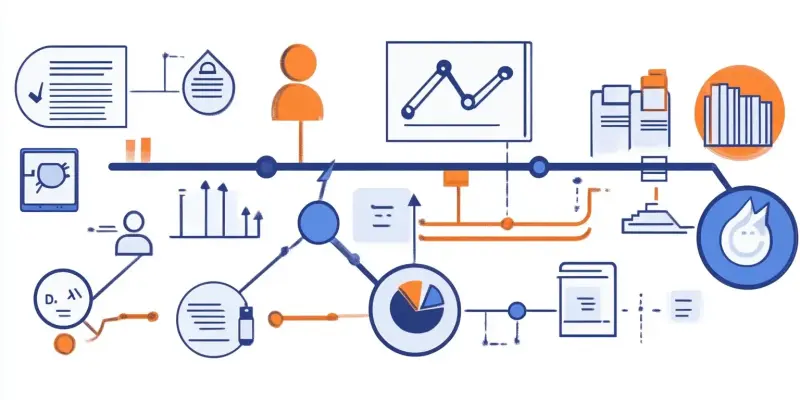B2B marketers have long understood that successful demand generation demands tailoring messages and offers to a buyer’s stage in the lead lifecycle. Early-stage buyers respond better to best practice and thought leadership content, while mid-stage buyers tend to be more receptive to case studies and webinars. However, once a prospect becomes a customer, this meticulous segmentation often disappears. Instead of receiving personalized communications, customers frequently find themselves lumped into a broad category, exposed to generic campaigns, messages, and offers. Instead of focusing on precise segments such as company size (SMB, Mid-Market, Enterprise), customer marketing becomes generalized. This approach overlooks significant opportunities to engage customers based on their unique relationship with a product.
A more effective strategy involves employing a lifecycle-based approach to customer marketing. This method ensures that marketing touchpoints align with where a company is in its customer journey, creating more relevant and meaningful interactions. Such an approach does more than maintain customer satisfaction; it drives upsell, cross-sell, retention, and advocacy. By structuring B2B customer marketing to mirror a customer’s journey, marketers can foster stronger relationships and sustainable growth.
Introduction & Initial Adoption
The initial stages of the customer lifecycle, encompassing onboarding and early adoption, are crucial for establishing a strong foundation. New customers require guidance, reassurance, and education to ensure a smooth onboarding experience. At this stage, the primary objective is to drive product adoption and set the stage for future expansion. Effective tactics in this phase include personalized welcome series, feature introductions, customer success check-ins, and community engagement.
A personalized welcome series can consist of email sequences crafted with set-up guides, training resources, and quick wins. These emails aim to make customers feel valued and supported from the outset. Furthermore, subtly introducing additional modules or premium features as “future-proofing” their current solution can create enthusiasm for future upgrades. Customer success check-ins, driven by personalized outreach from Customer Success Managers (CSMs), encourage ongoing engagement. Lastly, inviting customers to join user groups, webinars, or customer Slack channels fosters a sense of community and belonging, promoting deeper product engagement.
Development & Scaling
Once customers have successfully navigated the onboarding phase and are actively using the product, the focus shifts to development and scaling. This stage involves recognizing and responding to signals that indicate readiness for expansion, such as increased usage, hiring trends, or company growth. Effective marketing strategies during this phase should include behavior-based upsell campaigns, use case expansions, and exclusive offers.
Behavior-based upsell campaigns are triggered by specific customer actions, such as increased headcount, recent funding, or the addition of new seats. These campaigns tailor upsell messaging accordingly, ensuring relevance and timely engagement. Demonstrating how similar companies have leveraged additional features to scale their success can significantly influence customers considering expansion. Highlighting relevant case studies can be particularly compelling. Furthermore, providing exclusive offers, such as limited-time discounts or incentives for early adoption of premium features, encourages customers to upgrade and expand their usage. These strategies, properly executed, ensure that customers continue to derive maximum value from the product while fostering growth.
Key Users & Champions
With time, certain customers become highly engaged users and emerge as advocates for the brand. This group, often referred to as key users and champions, represents valuable opportunities for further engagement. To harness their potential, marketers can implement referral and advocacy programs, involve them in beta testing and VIP access opportunities, and encourage their participation in thought leadership activities.
Referral and advocacy programs reward customers for sharing testimonials, case studies, or referrals. Such programs not only recognize the valuable contributions these customers make but also incentivize further participation. Offering power users early access to new features through beta testing and VIP access initiatives fuels their enthusiasm and reinforces their status as valued customers. Engaging key users in thought leadership opportunities, such as participating in webinars, executive roundtables, user groups, trade shows, or co-branded content, amplifies their influence and strengthens their bond with the brand. These activities collectively transform key users and champions into powerful advocates, significantly enhancing brand visibility and credibility.
Renewal & Continuation
As customers approach the renewal phase, strategic communication becomes essential to minimize churn and encourage ongoing engagement. The primary objectives during this stage are to reinforce the product’s value, address potential concerns, and present attractive incentives for contract renewal or expansion. Key strategies include sending proactive renewal reminders, offering bundled pricing, and conducting customer success-driven outreach.
Proactive renewal reminders should be value-driven, emphasizing the return on investment (ROI) customers have experienced. These emails help remind customers of the benefits they’ve enjoyed so far and what they stand to gain by continuing their relationship with the brand. Bundled pricing, which offers incentives for upgrading or expanding the contract before renewal, can also be effective in securing long-term commitments. Additionally, personalized check-ins from customer success teams serve as an opportunity to address any concerns, discuss long-term value, and reinforce the shared goals between the customer and the provider. By focusing on these areas, marketers can ensure that the renewal process is seamless and mutually beneficial.
At-Risk Customers
Identifying and engaging at-risk customers is crucial for minimizing churn and maintaining a loyal customer base. For effective intervention, marketers should focus on early detection of disengagement signals such as decreased usage, missed payments, or reduced engagement with support. Implementing targeted re-engagement campaigns, personalized outreach, and offering personalized solutions can help re-establish customer trust and satisfaction.
Targeted re-engagement campaigns should respond to specific indicators of disengagement and offer tailored solutions to address potential issues. Personalized outreach from customer success teams can identify and resolve concerns before they result in churn. Additionally, customizing solutions based on feedback can demonstrate a genuine commitment to meeting a customer’s unique needs. This proactive approach can turn at-risk customers into loyal advocates, ensuring long-term retention and growth.
By adopting a lifecycle-based approach to customer marketing, B2B marketers can enhance their engagement strategies, drive sustained business growth, and build stronger customer relationships.

